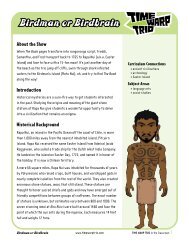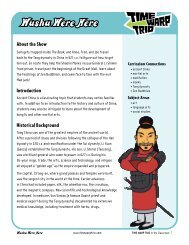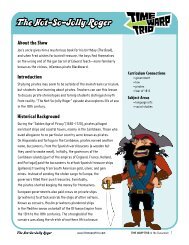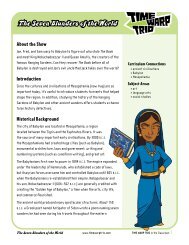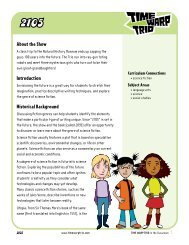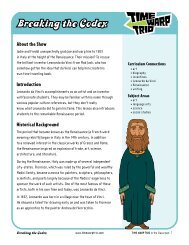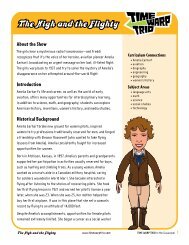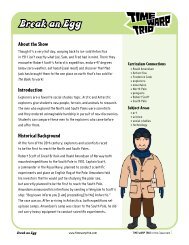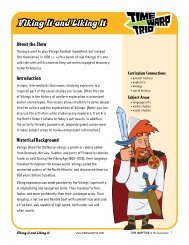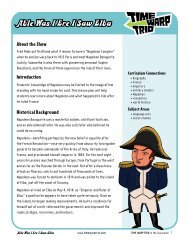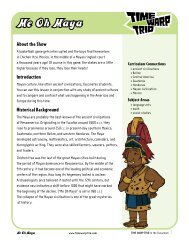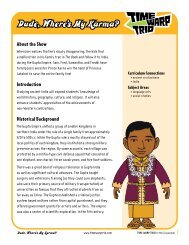Sam Samurai - Time Warp Trio
Sam Samurai - Time Warp Trio
Sam Samurai - Time Warp Trio
You also want an ePaper? Increase the reach of your titles
YUMPU automatically turns print PDFs into web optimized ePapers that Google loves.
<strong>Sam</strong> <strong>Sam</strong>urai<br />
About the Show<br />
An accidental haiku sends <strong>Sam</strong>, Joe, and Fred back to the beginnings<br />
of the Tokugawa Shogunate in 17th century Japan. Swords, samurai,<br />
and poetry contests challenge their talents.<br />
Introduction<br />
Learning about the culture and history of 17th century Japan through<br />
the study of the samurai, is an excellent way to enhance students’<br />
understanding of non-Western cultures and to compare and contrast<br />
world events during the time that Europeans were settling in America.<br />
This lesson also gives students the opportunity to explore different<br />
forms of poetry and storytelling, a tradition that many cultures share.<br />
Historical Background<br />
<strong>Sam</strong>urai, “those who serve,” were powerful members of the<br />
aristocracy who flourished between the 12th and mid–19th centuries.<br />
They were private soldiers who were hired to protect the property of<br />
powerful landowners.<br />
<strong>Sam</strong>urai lived according to the way of the warrior (bushido), an<br />
unwritten samurai code of conduct. Strongly influenced by the ideas<br />
of Confucius, samurai were self-disciplined, courageous,<br />
compassionate, and fiercely loyal to their masters. Honor was<br />
a samurai’s most valuable possession. If a samurai were to<br />
suffer a defeat, he was expected to commit ritual suicide<br />
(seppuku) rather than be dishonored by surrender, capture,<br />
or an ignoble death. Bushido is also the guiding principle behind<br />
kendo, one of several martial arts (such as judo and jujutsu) that<br />
originated in Japan.<br />
<strong>Sam</strong> <strong>Sam</strong>urai<br />
www.timewarptrio.com<br />
Curriculum Connections<br />
• art<br />
• Japan<br />
• world history<br />
Subject Areas<br />
• art<br />
• drama<br />
• language arts (poetry)<br />
• social studies<br />
<strong>Time</strong> <strong>Warp</strong> <strong>Trio</strong> In the Classroom
<strong>Sam</strong> <strong>Sam</strong>urai<br />
Historical Background continued<br />
The sword was the most famous weapon and symbol of the samurai. The true samurai was not only<br />
a trained warrior, but also an artist and philosopher. <strong>Sam</strong>urai cultivated the spirit and the mind through<br />
writing, painting, and calligraphy. As Jo says in the book <strong>Sam</strong> <strong>Sam</strong>urai, “<strong>Sam</strong>urai practice with their<br />
swords . . . and brushes.”<br />
<strong>Sam</strong>urai warriors were ruled by a leader called a shogun. Tokugawa Ieyasu was Shogun 400 years ago.<br />
Through both battles and diplomacy, he was able to bring stability to Japan after many years of war.<br />
When Tokugawa leyasu died in 1616—the same year as William Shakespeare—he left the Tokugawa family<br />
to rule over a peaceful Japan for the next 200 years.<br />
<strong>Sam</strong> <strong>Sam</strong>urai<br />
Want students to get even more<br />
excited about history?<br />
www.timewarptrio.com<br />
Check out the samurai adventure at<br />
www.timewarptrio.com/adventures/samurai/<br />
Put It Back, Jack! and other interactive games to play.<br />
Plentifax 487—the ultimate time traveler’s guide—to find out how the<br />
samurai lived and fought!<br />
Cool Books that kids will love.<br />
<strong>Time</strong> <strong>Warp</strong> <strong>Trio</strong> In the Classroom
Activity<br />
Write a Renga<br />
<strong>Sam</strong> <strong>Sam</strong>urai<br />
1<br />
in this activity, students review the format and content<br />
of haiku and learn about another traditional poetry form,<br />
the renga.<br />
Instructions<br />
. Distribute examples of haiku to students, such as those of the poet<br />
Issa, found at www.geocities.com/tokyo/island/5022/issa.html.<br />
Ask volunteers to read the haiku aloud.<br />
. Review the form and the content of haiku. You may want to mention<br />
the following:<br />
• Haiku is a type of Japanese poetry that is 400 years old. It is more<br />
like a quick sketch than a completed drawing.<br />
• Traditional haiku is about nature.<br />
• In Japanese, the form is very structured. A haiku must contain<br />
exactly 17 syllables.<br />
• Traditional haiku is three lines long: the first line has five syllables,<br />
the second line has seven, and the third line has five.<br />
• In Japan, haiku are valued for lightness, simplicity, openness, and<br />
depth. They are also appreciated for their surprise endings.<br />
• Modern haiku may use additional themes, such as humor, satire,<br />
romance, and modern life.<br />
. Decide if you want your students to create the traditional haiku—<br />
with exact syllable count, featuring a word that names or suggests<br />
a season—or if you will accept variations.<br />
4. As a class, write some sample haiku. Ask volunteers to read them aloud.<br />
5. Explain to students the characteristics of the renga (see the end note<br />
in the book <strong>Sam</strong> <strong>Sam</strong>urai). The renga is a long poem consisting of several<br />
connected short poems. The renga is generally created by two poets<br />
working together and building on each other’s ideas.<br />
Some view the renga as a competitive word game. The first verse of<br />
a renga is the hokku, or opening verse. A traditional hokku sets the poem<br />
in nature and contains a “season word” that indicates the time of year<br />
the renga takes place.<br />
www.timewarptrio.com<br />
Objectives<br />
• to understand the form of haiku<br />
• to work in small groups to create<br />
a cooperative poem (the renga)<br />
• to read poetry with expression<br />
Materials<br />
• art and writing supplies<br />
• “<strong>Time</strong> <strong>Warp</strong>s” handout<br />
• examples of Japanese<br />
watercolors (optional)<br />
Curriculum Standards<br />
• NCSS<br />
Culture: Students will give<br />
examples of how experiences<br />
may be interpreted differently<br />
by people from diverse cultural<br />
perspectives and frames of<br />
reference.<br />
• NCTe/ira<br />
Students develop an<br />
understanding of and respect<br />
for diversity in language<br />
use, patterns, and dialects<br />
across cultures, ethnic<br />
groups, geographic regions,<br />
and social roles.<br />
<strong>Time</strong> <strong>Warp</strong> <strong>Trio</strong> In the Classroom
Activity<br />
<strong>Sam</strong> <strong>Sam</strong>urai<br />
1<br />
6. Distribute the “<strong>Time</strong> <strong>Warp</strong>s” handout to demonstrate the renga form.<br />
7. Have students research life in 17th century Japan. Then divide the class<br />
into small groups—poetry societies—and have each group create a<br />
renga using a theme or topic related to what they have learned.<br />
8. Ask each poetry society to read their renga. The group may want<br />
to choose a representative from the group or have each member read<br />
a verse.<br />
9. Discuss the renga. Did the group successfully link the theme or topic?<br />
Did the verses fit the haiku form? You may want to award each group for<br />
their efforts with a prize, such as most vivid, most humorous, most<br />
informative.<br />
Take It Further<br />
Have students select a haiku they especially like—their own or a traditional<br />
haiku. Using their best handwriting and/or calligraphy, have students write<br />
their haiku with a marker or paintbrush. To enhance their work, they can<br />
create a watercolor border or illustration. You may want to display pictures<br />
of Japanese watercolors for inspiration.<br />
You may also want to ask students to put their renga or haiku to music<br />
using percussion instruments. Students can also create dance movements.<br />
You may want to challenge the poetry societies to create renga using<br />
contemporary themes or topics. Compare and contrast renga with other<br />
forms of modern expression, such as rap.<br />
www.timewarptrio.com<br />
<strong>Time</strong> <strong>Warp</strong> <strong>Trio</strong> In the Classroom 4
Swords, banners, armor<br />
On <strong>Sam</strong>’s kitchen table.<br />
1600 Japan.<br />
<strong>Sam</strong>urai<br />
In the shadows.<br />
Don’t lose your head.<br />
Real samurai<br />
Wear two swords.<br />
Read comic books.<br />
A smiling old woman<br />
Flaps her wings.<br />
Three girls land.<br />
Hot steaming<br />
Noodles<br />
Are delicious.<br />
Kimonos, castles,<br />
<strong>Time</strong> <strong>Warp</strong>s<br />
by Joe, <strong>Sam</strong>, and Fred<br />
Flag, wind,<br />
Mind flapping.<br />
Half-shaved head<br />
with ponytail.<br />
<strong>Sam</strong> samurai.<br />
Source: <strong>Sam</strong> <strong>Sam</strong>urai by Jon Scieszka. Illustrated by Adam McCauley. (Puffin 2002)<br />
<strong>Sam</strong> <strong>Sam</strong>urai www.timewarptrio.com <strong>Time</strong> <strong>Warp</strong> <strong>Trio</strong> In the Classroom<br />
© 2005 WGBH Educational Foundation.
Activity 2<br />
Japanese Storytelling Cards<br />
Kamishibai is a wonderful way to retell a story or to organize<br />
a report. it can be used by individuals, pairs, or small groups.<br />
Kamishibai works in social studies and in science as well. For<br />
instance, students can create endangered species kamishibai<br />
or use kamishibai to describe the respiratory system.<br />
Kamishibai can also be used to enhance reading comprehension<br />
by requiring students to retell story elements such as<br />
character, setting, conflict, and resolution.<br />
in this activity the students use Kamishibai to present<br />
information about 17th century Japan.<br />
Instructions<br />
. Organize students into pairs or small groups. Have them research life in<br />
17th century Japan, and identify five significant facts they have learned.<br />
. Ask students to draw a picture of one “fact” (the essential information)<br />
on each of five sheets of construction paper. These will become the<br />
kamishibai cards. Explain that Kamishibai (kaa-me-she-by) is a Japanese<br />
form of storytelling that uses large cards to tell a story. Kamishibai<br />
storytellers used to travel from village to village on their bicycles.<br />
In addition to storytelling, they also sold candy and acted as reporters,<br />
spreading the happenings of the region from place to place.<br />
When entering a village, the storyteller would clap wooden blocks,<br />
signaling his arrival. Villagers, young and old, would hurry to hear the<br />
story and the news. First, however, candy would be sold. Those<br />
who bought candy were given front row seats. The kamishibai were very<br />
popular from the 1920s through the early 1950s. After television was<br />
introduced, kamishibai gradually disappeared. Today, Japanese teachers<br />
and librarians are reviving kamishibai.<br />
. Have students write captions for each picture on a separate piece of<br />
paper. The captions will form a script that tells the story of the cards.<br />
4. Have students arrange the cards in a stack, with the first card in the<br />
story on top. The caption of the first card will go on the back of the last<br />
or bottom card. The caption for the second card will go on the back of the<br />
first card, and so on. This enables the storyteller to tell the story more<br />
smoothly. Have students paste their captions on the back of the pictures.<br />
<strong>Sam</strong> <strong>Sam</strong>urai<br />
www.timewarptrio.com<br />
Objectives<br />
• to read and research<br />
information on life in 17th<br />
century Japan<br />
• to edit and organize research<br />
Materials<br />
• six pieces of 12” x 12” white<br />
construction paper for each<br />
pair or small group<br />
• markers, colored crayons<br />
or pencils<br />
Curriculum Standards<br />
• NCSS<br />
Culture: Students will explain<br />
how information and<br />
experiences may be<br />
interpreted by people from<br />
diverse cultural perspectives<br />
and frames of reference.<br />
• NCTe/ira<br />
Students participate as<br />
knowledgeable, reflective,<br />
creative, and critical members<br />
of literacy communities.<br />
<strong>Time</strong> <strong>Warp</strong> <strong>Trio</strong> In the Classroom 6
Activity 2<br />
5. Use the sixth piece of construction paper to create a title page.<br />
Encourage students to make this page attractive and memorable. Include<br />
the names of the writer(s) on this page.<br />
6. Hold a Kamishibai Day and ask each pair or group to tell their story<br />
to the class. You may also want to present the stories to another class<br />
or to parents.<br />
Take It Further<br />
Have students read novels about samurai and about Japan. Have students<br />
create a kamishibai to retell the story in five to eight cards instead of<br />
writing a book report.<br />
<strong>Sam</strong> <strong>Sam</strong>urai<br />
www.timewarptrio.com<br />
<strong>Time</strong> <strong>Warp</strong> <strong>Trio</strong> In the Classroom 7
Resources<br />
Recommended Books<br />
For Teachers<br />
The Greenwood encyclopedia of<br />
Daily Life, Volume 4<br />
edited by Joyce E. Salisbury.<br />
(Greenwood Press, 2004)<br />
A comprehensive look at the lives<br />
of ordinary people—their clothes,<br />
food, culture, customs, beliefs, etc.<br />
in Search of the Spirit: The Living<br />
National Treasures of Japan<br />
by Sheila Hamanaka and Ayano Ohmi.<br />
(HarperCollins, 1999)<br />
Photographs, illustrations, and text<br />
combine to bring to life the gifted<br />
craftsmen of traditional Japan.<br />
Japan: its History and Culture<br />
by W. Scott Morton, 4th edition.<br />
(McGraw-Hill, 2004)<br />
A comprehensive look at Japan,<br />
from prehistory to the present.<br />
premodern Japan: a Historical Survey<br />
by Mikiso Hane. (Westview Press, 1990)<br />
This book traces the history of Japan<br />
up to their contact with the West.<br />
<strong>Sam</strong>urai: 1550–1600<br />
by Anthony J. Bryant.<br />
(Osprey Publishing, 1994)<br />
This book explores the culture,<br />
weapons, armor, and training of the<br />
samurai warrior class.<br />
<strong>Sam</strong>urai: The Story of Japan’s Great<br />
Warriors by Stephen Turnbull.<br />
(PRC Publishing, 2004)<br />
Detailed information about the<br />
legendary warriors, with see-through<br />
sections to illustrate the text. See<br />
also other books about the samurai<br />
by the author.<br />
Note: Teachers can purchase authentic kamishibai in English and Japanese from: Kamishibai for Kids, Cathedral Station, P.O. Box<br />
629, New York, NY 10025, Telephone 1-800-772-1228.<br />
<strong>Sam</strong> <strong>Sam</strong>urai<br />
For Students<br />
Fiction<br />
Blue Fingers, a Ninja’s Tale<br />
by Cheryl Aylward Whitesel.<br />
(Houghton Mifflin, 2004)<br />
Koji is kidnapped and forced to<br />
become a ninja in 16th century Japan.<br />
For older readers.<br />
The Boy Who Drew Cats adapted<br />
by Margaret Hodges.<br />
(Holiday House, 2002)<br />
Based on a legend about the famous<br />
15th century Japanese artist Sesshu<br />
Toyo, this is the story of a boy who<br />
could not stop drawing cats.<br />
The Crane Wife<br />
by Odds Bodkin. (Gulliver, 1998)<br />
A retelling of a Japanese folktale<br />
about a poor fisherman who gains<br />
a beautiful and talented wife.<br />
Audiotape available.<br />
The Demon in the Teahouse<br />
by Dorothy and Thomas Hoobler.<br />
(Philomel, 2001)<br />
In this suspenseful sequel to The<br />
Ghost in the Tokaido Inn, 14-year-old<br />
Seikei poses as a teahouse attendant<br />
to discover who is murdering geishas.<br />
Kazunomiya, prisoner of Heaven<br />
by Kathryn Lasky. (Scholastic, 2004)<br />
The Royal Diaries series. A fictional<br />
account of Princess Kazunomiya and<br />
the constraints and intrigues of the<br />
Japanese royal court.<br />
Kamishibai man by Allen Say.<br />
(Houghton Mifflin, 2005) An elderly<br />
kimishibai, long retired, returns to the<br />
city for one last performance.<br />
www.timewarptrio.com<br />
Kogi’s mysterious Journey adapted<br />
by Elizabeth Partridge. (Dutton, 2003)<br />
Kogi captures a fish in order to<br />
draw it, but he finds peace and great<br />
beauty when he sets the fish free.<br />
revenge of the Forty-seven<br />
<strong>Sam</strong>urai by Erik Christian Haugaard.<br />
(Houghton Mifflin, 1995)<br />
Jiro, a servant to one of the samurai<br />
planning to avenge an unjust death,<br />
must act as his master’s spy in<br />
feudal Japan.<br />
<strong>Sam</strong> <strong>Sam</strong>urai<br />
by Jon Scieszka. Illustrated by Adam<br />
McCauley. (Puffin, 2002)<br />
While doing a homework assignment<br />
on haiku, the <strong>Trio</strong> find themselves in<br />
17th century Japan—and in danger.<br />
Sword of the <strong>Sam</strong>urai: adventure<br />
Stories from Japan<br />
by Eric A. Kimmel. (Harcourt, 1999)<br />
Eleven stories of Japan’s knights, the<br />
samurai, include action, drama,<br />
humor, and wisdom.<br />
Tanuki’s Gift by Tim Myers.<br />
(Marshall Cavendish, 2003)<br />
A Buddhist priest and a tanuki find<br />
the gift of their friendship to be more<br />
valuable than they realize.<br />
The Valley of the Broken Cherry Trees<br />
by Lensey Namioka. (Delacorte, 1980)<br />
Zenta and Matsuzo, two wandering<br />
ronin, decide to stop at a small inn<br />
and enjoy the spring cherry blossoms,<br />
but they soon find themselves<br />
embroiled in intrigue and mystery.<br />
<strong>Time</strong> <strong>Warp</strong> <strong>Trio</strong> In the Classroom 8
Resources<br />
Nonfiction<br />
Calligraphy for Kids<br />
by Eleanor Winters. (Sterling, 2004)<br />
Assemble the appropriate tools and<br />
follow the step-by-step instructions<br />
for making the letters for four<br />
different alphabets.<br />
China and Japan<br />
by Paula Hammond. (Mason Crest, 2002)<br />
Cultures and Costumes series. Shows<br />
the traditional dress for all segments<br />
of Japanese society, from the royal<br />
court to a traveling priest.<br />
Commodore perry in the Land of the<br />
Shogun by Rhoda Blumberg.<br />
(Lothrop, 1985)<br />
When Commodore Matthew C. Perry<br />
sailed into Edo Bay in 1853, he and his<br />
men found a society that had changed<br />
little in almost 250 years.<br />
Grass Sandals: The Travels of Basho<br />
by Dawnine Spivak. (Atheneum, 1997)<br />
The best-loved poet of Japan walked<br />
throughout the country observing<br />
nature and composing poems.<br />
Hokusai: The man Who painted<br />
a mountain<br />
by Deborah Kogan Ray. (Farrar, 2001)<br />
This is a picture book biography of<br />
one of Japan’s most prolific painters<br />
whose paintings of Mount Fuji are<br />
famous the world over.<br />
i Live in Tokyo by Mari Takabayashi.<br />
(Houghton Mifflin, 2001)<br />
Mimiko describes life in modern-day<br />
Tokyo, including daily activities,<br />
customs, holidays, and food.<br />
Japan in the Days of the <strong>Sam</strong>urai<br />
by Virginia Schomp.<br />
(Marshall Cavendish, 2002)<br />
Describes the beginning of the<br />
samurai, their artistic achievements,<br />
their religion, how they shaped<br />
society, and their present-day legacy.<br />
modern Japan: a History in<br />
Documents by James L. Huffman.<br />
(Oxford University Press, 2004)<br />
Japan’s history, from the time of the<br />
shogun to the present day, is<br />
explored using primary sources.<br />
<strong>Sam</strong>urai by Paul Collins.<br />
(Chelsea House, 2002)<br />
Photographs, drawings, maps, and<br />
timelines show the history, armor,<br />
and weapons of samurai, including the<br />
famous swordsman Miyamoto<br />
Musashi.<br />
<strong>Sam</strong> <strong>Sam</strong>urai www.timewarptrio.com<br />
Poetry<br />
Cool melons—Turn to Frogs! The Life<br />
and poems of issa by Matthew<br />
Gollub. (Lee & Low, 1998)<br />
Delicate pencil and watercolor<br />
illustrations complement this poetic<br />
biography of Issa, Japan’s beloved<br />
author of haiku.<br />
one Leaf rides the Wind: Counting<br />
in a Japanese Garden by Celeste<br />
Davidson Mannis. (Viking, 2002)<br />
The author uses haiku poems to<br />
count objects in a traditional<br />
Japanese garden and provides facts<br />
about Japanese history and life.<br />
<strong>Time</strong> <strong>Warp</strong> <strong>Trio</strong> In the Classroom 9
Resources<br />
Web Sites<br />
BaSHo’S LiFe<br />
darkwing.uoregon.edu/~kohl/<br />
basho/life.html<br />
A description of master haiku poet<br />
Matsuo Basho’s life and poetry.<br />
HaiKu iN WeSTerN LaNGuaGeS<br />
terebess.hu/english/haiku/<br />
haiku.html<br />
This index offers links to specific<br />
authors and to general commentary<br />
on this form of poetry.<br />
aN iNTroDuCTioN To HaiKu<br />
www.geocities.com/Tokyo/<br />
island/5022/<br />
This site explains the structure of<br />
traditional haiku and includes the<br />
biographies and poetry of Basho,<br />
Buson, and Issa.<br />
<strong>Sam</strong>urai<br />
www.japan-guide.com/e/e2127.html<br />
This brief overview of the history of<br />
the samurai offers links to more<br />
information.<br />
<strong>Sam</strong>urai CuLTure<br />
www.samurai-archives.com/<br />
cultcat.html<br />
This site offers short descriptions of<br />
famous figures in the samurai culture,<br />
as well as links to samurai food,<br />
clothing, philosophy, and more.<br />
<strong>Time</strong> <strong>Warp</strong> <strong>Trio</strong><br />
www.timewarptrio.com<br />
This site for kids includes interactive<br />
games, fascinating facts, and booklists<br />
that help make the past come alive.<br />
<strong>Sam</strong> <strong>Sam</strong>urai<br />
please note:<br />
Although these sites were verified at the time<br />
of publication, Web site addresses and content<br />
are frequently subject to change.<br />
©2005 WGBH Educational Foundation. All rights reserved. <strong>Time</strong> <strong>Warp</strong> <strong>Trio</strong> is produced by WGBH in association with Soup2Nuts for Discovery Kids.<br />
Major funding was provided by a grant from the National Endowment for the Humanities. Any views, findings, conclusions, or recommendations expressed in these classroom materials do not necessarily<br />
represent those of the National Endowment for the Humanities. Based on THE TIME WARP TRIO book series written by Jon Scieszka and illustrated by Lane Smith.<br />
<strong>Time</strong> <strong>Warp</strong> <strong>Trio</strong> is a registered trademark of Chucklebait, LLC. Used with permission. Third party trademarks are the property of their respective owners. Used with permission.<br />
www.timewarptrio.com<br />
<strong>Time</strong> <strong>Warp</strong> <strong>Trio</strong> In the Classroom 0



